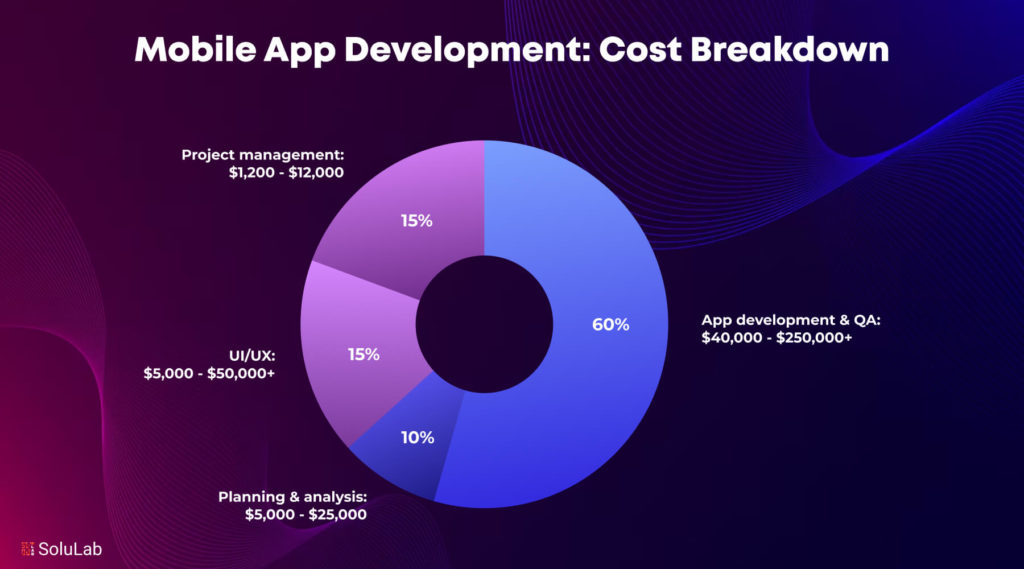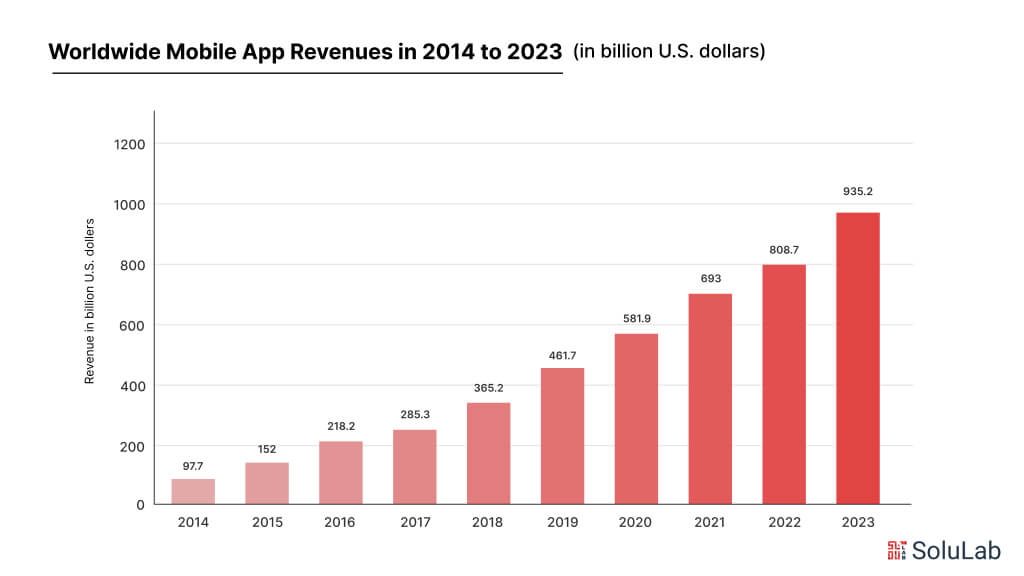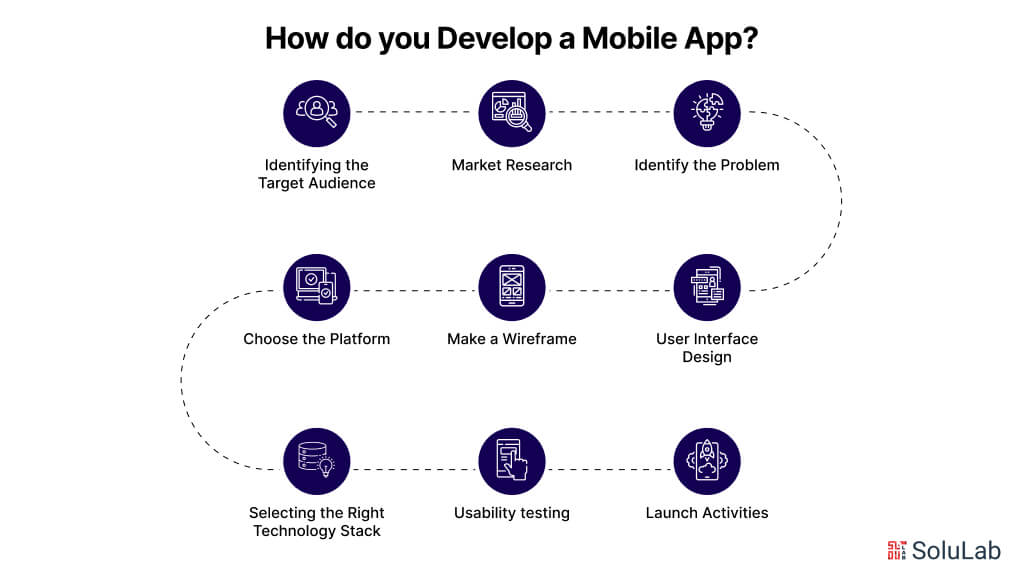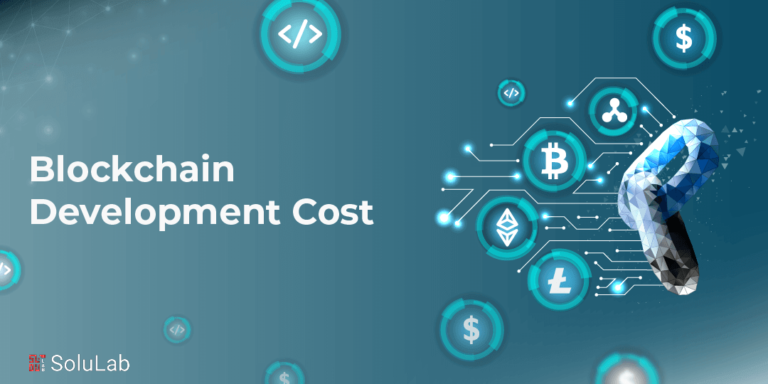
Beginning from the early 90s and continuing till date, mobile app development costs have evolved significantly becoming essential for business growth. Numerous companies have transitioned to the digital realm, using apps to compete. The question of the hour is “What is the Cost of Mobile App Development?” There is an app for everything these days, making it easier for consumers and businesses to buy. What is the real deal with mobile app development, and how much does it cost? All these questions never have a single answer to them.
We have cracked the code to make it easier for many who seek to understand. This blog will provide you with a breakdown of every factor, step, and component involved in app development, which will empower you to estimate the precise cost of your app. The global mobile application market size was valued at USD 252.89 billion in 2023 and is projected to grow at a compound annual growth rate (CAGR) of 14.3% from 2025 to 2030.
Cost of Mobile App Development in 2025
Whenever a client heads to a mobile app development for a consultation on their app idea, they often find themselves in the dark about the whole development process and the costs involved. Even if they have laid out their requirements and functions it may not be enough for the estimation of price. The initial cost is given by the agency but that’s not entirely how it works. App development is a much more complex journey and is the key factor for understanding the expense it may hold with appropriate research.
The Breakdown of mobile app development cost is based on complexity for finding out the estimate of how much it may cost:
| Application Type | Cost |
| Basic Application– Games, Social Media, Clocks, and Simple Utilities | Project Management- $1,000-$3,000
UI/UX- $3,000-$5,000 Planning and Analysis- $2,000-$4,000 Development- $6,000-$12,000 Testing- $1,000-$3,000 |
| Mid-Level Applications– E-commerce, Chat, and Food Delivery Apps | Prjoect Management- $3,000-$6000
UI/UX- $5,000-$10,000 Planning and Analysis- $4,000-$8,000 Development- $12,000-$25,000 Testing- $3,000-$6,000 |
| Complex Applications– Enterprises, Logistics, gaming, and health applications. | Prjoect Management- $6,000-$10,000
UI/UX- $10,000-$20,000 Planning and Analysis- $8,000-$15,000 Development- $25,000-$50,000 Testing- $6,000-$10,000 |
The expense of creating an app boils down to these five key factors as well:
- Functionalities: What tasks are supposed to be performed by the app and the needs it will need to meet for users?
- Complexity of Features: Be it a high or a basic app, or a to-do list, feature complexity affects the development cost and intricacy.
- Platforms: Choosing between native and cross-platform development for single and multiple platforms.
- Maintenance: Planning for ongoing technical support after the app is launched to make sure it is running smoothly and ensure its potential enhancements.
- Third-Party Integrations: Integrating external services like location services and payment options can impact the overall cost of developing an app.
Instead, you can even simply do things with a mobile app development cost calculator to have an estimate of the expenses accurately.

Factors Affecting the Costs of a Mobile App Development?
The ultimate cost of developing a mobile app and an Android app hinges on various aspects like app complexity, included features, and the developer’s location. Let’s have a look at the factors influencing the expenses of mobile app development step by step:
1. Mobile App Complexity
Developing a simple app ranges from $5,000-$50,000. These apps provide fundamental user features like login systems, user profiles, dashboards, and basic administration capabilities. Whereas for a medium-complex app, the cost falls between $50,000- $120,000. These apps not only provide an array of features but also incorporate user privacy settings, payment getaways, audio-video streaming, and more. For example, domino’s UI/UX strategy boosted conversion by23%. On the other hand, complex apps can cost about $100,000-$300,000 and beyond. These apps make use of technologies like AR/VR, AI, and Machine Learning.
2. App Features and Functions
The mobile app development cost estimate of crafting an app mostly depends on the features and functions you include for your app. The initial cost of mobile app development for your desired app type escalates as you add more features. It’s better to focus on the crucial features of the first version of your app. This approach makes sure that the user experience is made accessible at a reasonable price. By choosing a Minimum Viable Product (MVP) with a basic feature set you can save both time and money. Here is a breakdown of the cost and time required for basic features:
| Features | Functions | Required Time | Average Expense |
| Login | Login with Social Handles
Email Login Option of Password Recovery Logout Options |
30-42 Hours | $500-$1,000 |
| Completing Profile | Adding Formal Information
Photo Opting Location Services |
30-40 Hours | $900-$1,000 |
| Messaging | Active/Inactive Visibility Typing StatusSending Files and MediaDelivered and Read Update |
170-180 Hours | $3,000-$5,000 |
| Notifications | Push Notificnats and Reminders for users | 25-32 Hours | $1,000-$1,200 |
| User Management | Delete/Block User
Edit User Block Options |
66-69 Hours | $3,500-$4,000 |
3. Category of Apps
The mobile app development cost is also dependent on the category it falls into. Category is defined with various changes like user base, features, security, and other requirements. All these differences result in varying development costs for an app. Here are most of the popular categories for mobile app development:
- E-Commerce: Applications like Amazon are highly renowned because of their extensive features which allow them to function in real-time, handling a large number of users and maintaining strong security measures.
- Social Media Apps: These apps involve third-party integrations for utilizing hardware functions like cameras and audio recorders. They are designed to be highly scaleable for supporting the number of users.
- Custom Apps: Even the simplest on-demand apps comprise three versions- for users, for individuals, and for the business.
- Hardware-Dependent Apps: All of the apps using IoT technology are made hardware-independent to indulge in functions like extracting data and sending commands for required actions.

4. Animations and Designs
The other major factor affecting the cost of developing an app development mobile is the design. To ensure the engagement of users with the app, you would require a strong focus on the designs for the app. When the designs are the talk, you have two choices Custom UI and Standard UI. The customized UI is more complex in design and implementation making it pricier while Standard UI is a reasonable option. The main components included in mobile app design development are as follows:
- Animation: Animations are used widely amongst designers to enhance the user experience and engagement for apps, majorly in social media and gaming fields.
- Wireframing: Developers mostly use wireframing tools like Photoshop to create a more user-friendly layout of an app.
5. Platform
When you are willing to get an app for your business, you have to choose a platform for it that will help estimate the cost behind it. Choosing the platform solely relies on your audience, you can go for iOS, android, web apps, and cross-platform applications. If you have a startup with a limited budget, going for a single platform is advised. These are the most common application development platforms:
- Native: iOS apps are developed using a C objective, while Android apps are built using Java and Kotlin.
- Web Apps: Progressive web apps and any other web app variant are more cost-effective in comparison to native apps. These apps range from $15,000 to $50,000.
- Cross-Platform: The apps that are developed for both iOS and Android simultaneously are a cost-effective trend. For example, flutter offers reduced development efforts.
- Hybrid: These apps combine the features from both web apps and native platforms. They can easily be installed like native apps but will function within a web view component.
6. Maintenance
The expenses are not limited till the development of the apps, goes beyond it. Businesses have to constantly update their apps to adapt to the changing market trends, new models, and operating versions. Here is the breakdown of factors that require expenses even after the app is developed:
- Bug Fixes: Every app has bugs, some of which surface only when the app is launched. Therefore it is crucial to monitor and resolve these bugs as soon as they come.
- Changes in Designs: App designs get outdated and can potentially lose the appeal for users. To keep the app designs fresh it is important to retain as per user interests.
Major Mobile Apps and Their Cost of Development

Here are some of the most known apps that have been reshaped and transformed with time as per user experiences, and recently are dominating the app market. The details of each app are provided below which will help you with insights into how the cost of developing a mobile app may depend on the functions, complexity, and design needs of all kinds of apps
-
Snapchat
Snapchat boasts more than 300 million active users daily and has reshaped the dynamics of social media apps. This highly-used platform is at the forefront of introducing augmented reality features using filters and lenses for users. In addition, this app allows users to share messages along with media that can vanish in up to 10 seconds. The average cost of developing Snapchat for a single platform is $45,000-$100,000 and goes up to $200,000 for both platforms.
-
WhatsApp
A messaging app that enables users to chat, make instant video and audio calls and send videos, photos, and more. The typical cost to develop a messaging app like Whatsapp mostly varies from $30,000-$70,000.
-
Uber
Uber stands out as the most liked ride and sharing app that links users to drivers for a safe and comfortable ride to their destination. With the help of this app, users can swiftly find a ride instantly or for a scheduled time. The typical cost for developing a similar app ranges from $30,000-$100,000.
-
Netflix
Netflix has emerged as the top media streaming platform globally. This allows users to stream shows and movies whenever they feel like. The average cost for developing an app like Netflix starts from $25,000-$200,000.
These were some estimations of how much it would cost to create apps similar to the globally used leading ones.
How do you Develop a Mobile App?

The process of developing mobile apps is methodical and encompasses many steps, from concept to implementation and maintenance. It involves strict planning, designing, development, testing, and marketing for the satisfaction of the user’s needs and to make a difference in crowded markets. Here is a comprehensive guide on how to develop mobile apps
1. Research and ideation
The development of a mobile app begins with idea generation and in-depth research. This step includes:
- Identifying the Target Audience: It involves understanding who the audience is so that more personalized work can be put into the features and layout of the app for the end-user.
- Market Research: It involves looking at existing apps to identify an opportunity or opening in the market. All the various competitors need to be studied with their pros and cons.
- Identify the Problem: Clearly state the problem that your software is to solve. This will ensure there is no relevance and guide the development process.
2. Planning
The step after confirming the idea is planning:
- Describe App Features: List down the primary features to be included in your application. Prioritize them by technical feasibility and user requirements.
- Choose the Platform: Whether you want to develop for Android, iOS, or both, this will have an impact on programming languages, design, and development tools.
- Make a Wireframe: The wireframe or prototype of an application will let you see what the UI and layout look like. This helps in understanding user flow and in visualizing what issues might come up down the track.
- Designing User Experience (UX): The software should be user-friendly and intuitive. Consider the usability, accessibility, and navigation of apps.
- User Interface Design: The designing of the font, color schemes, and icons for the application. It has to be attractive to the target audience but at the same time in light of the brand identity.
Read Blog: Mobile App Development for Businesses
3. Development
With a ready design, development commences:
- Selecting the Right Technology Stack: From among the host of development tools, choose suitable frameworks and programming languages for the Application. In the case of Android, it would be Java or Kotlin; for iOS, it would be Swift or Objective-C.
- Frontend Development: Build the User Interface of an application with the designs produced earlier. This involves putting features into practice and making sure that various devices are responsive.
4. Testing
Testing is essential to ensure that the program works properly and is bug-free:
- Functional Testing: Check that all features work as expected. This is meant to test user interactions, data processing, and the performance of applications.
- Usability testing: Engage real users to find out usability issues. This would enhance the software before its release into the market.
- Performance testing: The app performance under different scenarios has to be tested—across various network speeds and device types.
5. Implementation
Once testing is done, the application is good to go to market:
- App Store Guidelines: Avoid getting rejected. The software must adhere to all the guidelines of their respective app stores (Play Store, Apple Software Store).
- Launch Strategy: Whether your app requires a press release or influencing people before launching the app, comes under marketing plans that should be all set before its launch. Press releases, collaborations with influencers, and social media marketing are some examples.
- Apply: Once you add an app to selected app stores with screenshots, synopsis, and marketing materials, you are good to go.
How can Apps Make Money?
There is not a single way to use apps to make money. But how exactly does that work, how are apps making money even the free ones?
Apps are monetized through various means, meaning that developers can still benefit even if they distribute their apps for free. In-app ads are likely the most common form, where dedicated developers are paid based on impressions gleaned from app users. These can take the form of interstitial ads—an ad that takes over the whole screen on a device at natural transition points in an app—rewarded video ads, where a person views a video ad in exchange for an in-app reward, or a banner ad, which is smaller and appears at the top or the bottom of an app screen.
In this business model, users of subscription-based apps pay a regular price to access premium features or content. The model is applied when the service-to-be provided is supposed to generate a continuous income stream, as long as users consent to the payment of recurrent fees to be able to continue using the application or service. For mobile app developers, other ways in which apps can be monetized are with affiliate marketing and sponsorships. Developers can team up with brands that are promoting products or services in their app with affiliate links and also with an increase in affiliate sales percentage, inducing a commission for sales generated by them through their referrals. This works very well for applications that have real ardent user bases associated with specific companies.
The Final Word
Developing mobile applications is a procedural process for Mobile App Development Company, involving various conceptualization steps, implementation, and maintenance processes. This whole process involves lean planning, designing, development, testing, and marketing, specifically aimed at ensuring that the app satisfies the users and that it makes a difference in the thronged market. If you hire an App developer, you can map out a winning app with such steps, and this will enable them to make big from the variety of monetization strategies of monetization ranging from IAPs to subscriptions, sponsorships, freemium, and in-app advertising. The app is considered to be current and competitive for a long period, thanks to its continuous development based on users’ feedback and the general development of technology.
In such a situation, you are supposed to look to collaborate with a reputable mobile app development company of the likes of SoluLab. With strategy, design, development, and marketing expertise, Solulab can help bring app ideas to life and maximize revenue.
FAQs
1. Which phases are most important in the development of a mobile app?
The important phases in the creation of mobile apps are ideation and research, planning, design, development, testing, deployment, and maintenance.
2. How can apps generate revenue?
There are so many methods of monetization that the app uses to generate revenue, such as in-app advertisement, freemium models, in-app sales, subscription, and sponsorship models, among others.
3. What is the freemium model?
The freemium model involves the free downloading of software but charges a fee for additional premium features or content. This provides attraction to more users and probably raises the conversion speed of premium features.
4. Why is testing important in mobile application development?
Testing is important to make sure that the software works perfectly, is bug-free, and offers a flawless user experience. Performance testing, usability, and functionality are all part of it.
5. Why is SoluLab a trustworthy provider of mobile app development services?
SoluLab has successfully designed applications for numerous startups and big corporations around the world. Specifically in cross-platform development and custom application design, helping businesses reap the maximum revenue.





